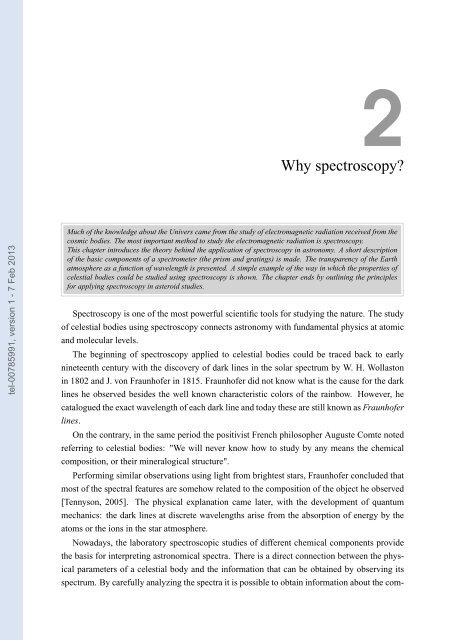Techniques d'observation spectroscopique d'astéroïdes
Techniques d'observation spectroscopique d'astéroïdes
Techniques d'observation spectroscopique d'astéroïdes
You also want an ePaper? Increase the reach of your titles
YUMPU automatically turns print PDFs into web optimized ePapers that Google loves.
2<br />
Why spectroscopy?<br />
spectrum. By carefully analyzing the spectra it is possible to obtain information about the comtel-00785991,<br />
version 1 - 7 Feb 2013<br />
Much of the knowledge about the Univers came from the study of electromagnetic radiation received from the<br />
cosmic bodies. The most important method to study the electromagnetic radiation is spectroscopy.<br />
This chapter introduces the theory behind the application of spectroscopy in astronomy. A short description<br />
of the basic components of a spectrometer (the prism and gratings) is made. The transparency of the Earth<br />
atmosphere as a function of wavelength is presented. A simple example of the way in which the properties of<br />
celestial bodies could be studied using spectroscopy is shown. The chapter ends by outlining the principles<br />
for applying spectroscopy in asteroid studies.<br />
Spectroscopy is one of the most powerful scientific tools for studying the nature. The study<br />
of celestial bodies using spectroscopy connects astronomy with fundamental physics at atomic<br />
and molecular levels.<br />
The beginning of spectroscopy applied to celestial bodies could be traced back to early<br />
nineteenth century with the discovery of dark lines in the solar spectrum by W. H. Wollaston<br />
in 1802 and J. von Fraunhofer in 1815. Fraunhofer did not know what is the cause for the dark<br />
lines he observed besides the well known characteristic colors of the rainbow. However, he<br />
catalogued the exact wavelength of each dark line and today these are still known as Fraunhofer<br />
lines.<br />
On the contrary, in the same period the positivist French philosopher Auguste Comte noted<br />
referring to celestial bodies: "We will never know how to study by any means the chemical<br />
composition, or their mineralogical structure".<br />
Performing similar observations using light from brightest stars, Fraunhofer concluded that<br />
most of the spectral features are somehow related to the composition of the object he observed<br />
[Tennyson, 2005]. The physical explanation came later, with the development of quantum<br />
mechanics: the dark lines at discrete wavelengths arise from the absorption of energy by the<br />
atoms or the ions in the star atmosphere.<br />
Nowadays, the laboratory spectroscopic studies of different chemical components provide<br />
the basis for interpreting astronomical spectra. There is a direct connection between the physical<br />
parameters of a celestial body and the information that can be obtained by observing its
















